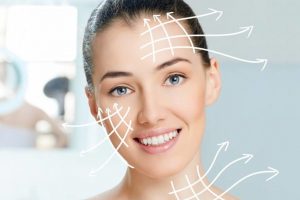With all the improved types of energy based technologies increasingly available on the market, pinpointing a favorite system is impossible. Nevertheless, every month I will share the merits and research highlights of some energy based technologies I find yield sustained effective outcomes.
What Type Of Energy Based Technology Is The Ultherapy?
The Ultherapy system (Merz North America Inc., Raleigh, NC) was first developed in 2004 and is now recognized as a safe and reliable means for non-surgical tightening and lifting of lax tissues. It is the first and only ultrasound platform device to receive FDA approval for lifting skin on the eyebrows, the neck, submental area and decollete.
The device combines micro focused ultrasound with real-time visualization (MFU-V). The high-resolution ultrasound imaging technology known as DeepSE (Ulthera, Inc., Mesa, AZ) permits the user to visualize planned treatment areas and to avoid treating non-target tissues such as bone and large blood vessels.
Target Specific Anatomical Layers With Varying Depths
The Ultherapy device may be fitted with either of three different transducers that deliver the Ultrasound (US) energy at depths of 4.5, 3.0 or 1.5 cm. The decision as to which transducer is used will depend on the anatomical layer to be treated; namely the SMAS or the Dermis. Patients vary in skin thickness and anatomical features on the basis of their age, body weight, gender and ethnicity, hence effective visualization is of paramount importance so as to ensure customization of the treatment for each individual patient.
In general, the areas with the thinnest skin, such as the neck and periocular area, should be treated with superficial depth probes; the brow and temple should be treated with superficial and deeper probes; and cheek and submental skin is best treated with the deepest 4.5-mm probe followed by additional treatment with a superficial probe.
Watch Out For ‘Copycat’ Devices
There are currently, other ‘copycat’ High Intensity Focused Ultrasound (HIFU) devices on the market, none of which include the diagnostic imaging option and hence the transducers are used randomly by the operator without any indication of which depth is being treated. None of these other copycat devices have FDA approval, which in essence could mean that the safety and efficacy data is not totally complete for these devices. The U.S. FDA is much more stringent in safety and efficacy, plus there are patent issues with Ulthera and the other HIFU devices.
Behind The Scenes: Mechanism Of Action
 The Superficial musculoaponeurotic system (SMAS) is an extracellular fibrous matrix consisting of collagen and elastin, closely associated with specific facial muscles including the occipitofrontalis, orbicularis oculi, levator labii superioris, zygomaticus major and minor and the platysma. Since aging is normally associated with a 5% decrease in the skin’s collagen with each decade, decreased collagen content in the dermis and SMAS may lead to undesirable manifestation of aging including lines, wrinkles and skin sagging.
The Superficial musculoaponeurotic system (SMAS) is an extracellular fibrous matrix consisting of collagen and elastin, closely associated with specific facial muscles including the occipitofrontalis, orbicularis oculi, levator labii superioris, zygomaticus major and minor and the platysma. Since aging is normally associated with a 5% decrease in the skin’s collagen with each decade, decreased collagen content in the dermis and SMAS may lead to undesirable manifestation of aging including lines, wrinkles and skin sagging.
The MFU-V is capable of transcutaneous heat delivery, whereby tightly focused zones of the deeper subdermal connective tissue are heated to a temperature of >60 degrees to create thermal injury zones (TIZ’s). The micro-wounding results in immediate contraction of denatured collagen followed by a powerful wound healing response and robust collagen remodeling.
Clinical Considerations
The clinical response is one of an immediate as well as long term skin tightening with optimal results being achieved at six months post treatment. In fact, typically post-treatment photographs are taken six months later. Maintenance treatments are recommended once every 12 months.
The treatment is safe, however, it is best to avoid treating the auricular area, particularly adjacent to the earlobe, as facial nerves are more superficial in these areas and could be inadvertently affected. At MFU-V treatment depths may be somewhat uncomfortable necessitating the use of topical anesthesia and distraction techniques such as use of stress ball or cool air blower.
For optimal clinical outcomes, currently, MFU-V is being advocated in combination with other aesthetic treatments. In fact, a common practice nowadays is the pre-treatment of the skin with a collagen stimulator such as hyper-dilute calcium hydroxylapetitie or poly-l-lactic acid. This practice optimizes the level of neocollagenesis achieved by the MFU-V treatment.
References
Fabi, et al. Optimising Patient Outcomes by Customizing Treatment with Microfocused Ultrasound With Visualization: Gold Standard Consensus Guidelines from an Expert panel. Journal of Drugs in Dermatology. 2019; 18:426-432
Fabi et al. Combined aesthetic interventions for prevention of facial aging, and restoration and beautification of face and body. Clin. Cosmetic and Investigational Dermatology. 2017:10 423–429
This blog is not sponsored and is free of any commercial bias towards Ulthera or Merz Aesthetics.
